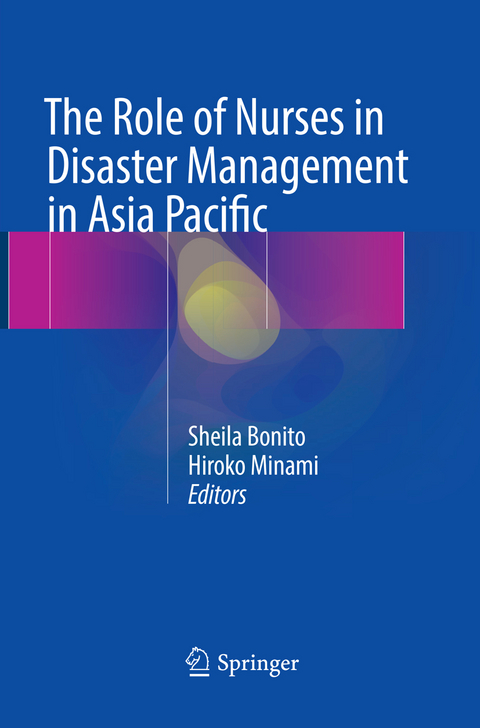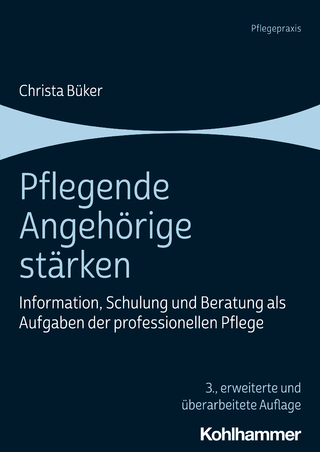
The Role of Nurses in Disaster Management in Asia Pacific
Springer International Publishing (Verlag)
978-3-319-82320-1 (ISBN)
Sheila R. Bonito is Professor at the University of the Philippines Open University. She served as Chair of Disaster Preparedness Committee of the Philippine Nurses Association from 2010-2015. She has published modules, case studies, journal articles and advocacy materials on emergency and disaster management. She is a resource person in emergency and disaster nursing training programs at the Philippine Nurses Association and the Asian Disaster Preparedness Center. She is an active member of the Asia Pacific Emergency and Disaster Nursing Network organized by the World Health Organization Western Pacific and Southeast Asian regions. Professor Hiroko Minami is an eminent nurse leader in Japan who has been working diligently for the advancement of nursing in Japan including education, service and research for more than 30 years. Prof. Hiroko Minami received her basic nursing education form Kochi Woman's University, Japan. She later received the Master Degree in Public Health form Hebrew University, Israel, and Doctoral of Nursing Science Degree from University of California, San Francisco.She is the 2001 recipient of the Distinguished Alumna Award, the past President of the International Council of Nurses, and is currently President of the University of Kochi, Japan.
1. Introduction.- 1.1. The Asia Pacific region and natural disasters.- 1.2. The role of nurses in disaster management.- 1.3. Purpose of the book and intended audience.- 2. Disaster Nursing Framework and Method.- 3. Disaster Nursing Case Studies from Asia Pacific.- 3.1. Australia - 2011 Cyclone Washi, 2009 Wildfires.- 3.2. Cambodia - 2011 Riverine flood.- 3.3. China - 2008 Wenchuan Earthquake, 2010 Riverine flood (May 29 -Aug 31).- 3.4. Indonesia - 2006 Yogyakarta Earthquakes, 2014 volcanic eruptions.- 3.5. India - 2013 Riverine flood (June 12-27).- 3.6. Japan - 2011 Tohoku Earthquake and Tsunami (March 11).- 3.7. Myanmar - 2008 Cyclone Nargis.- 3.8. Nepal - 2015 Earthquake.- 3.9. New Zealand - 2010 Christchurch Earthquake.- 3.10. Philippines - 2012 Typhoon Pablo, 2013 Typhoon Haiyan, 2013 Bohol Earthquake.- 3.11. Samoa - 2009 Tsunami.- 3.12. South Korea - 2015 MERSCoV.- 3.13. Thailand - 2012 Riverine Flood (August 5, 2011 to January 4, 2012).- 3.14. Vanuatu - 2015 Cyclone Pam (March 15, 2015).- 4. Analysis: Contribution of Nurses in Disaster Management.- 4.1. Disaster prevention and mitigation.- 4.2. Disaster preparedness.- 4.3. Disaster response.- 4.4. Disaster recovery and rehabilitation.- 5. Conclusion.
| Erscheint lt. Verlag | 3.8.2018 |
|---|---|
| Zusatzinfo | X, 115 p. 34 illus., 33 illus. in color. |
| Verlagsort | Cham |
| Sprache | englisch |
| Maße | 155 x 235 mm |
| Gewicht | 2291 g |
| Themenwelt | Medizin / Pharmazie ► Medizinische Fachgebiete ► Intensivmedizin |
| Medizin / Pharmazie ► Medizinische Fachgebiete ► Notfallmedizin | |
| Medizin / Pharmazie ► Pflege ► Pflegemanagement / Qualität / Recht | |
| Pflege ► Studiengänge ► Pflegewissenschaft | |
| Schlagworte | Asia Pacific • Case Studies • disaster management • Disaster nursing • disaster risk reduction • nurses |
| ISBN-10 | 3-319-82320-5 / 3319823205 |
| ISBN-13 | 978-3-319-82320-1 / 9783319823201 |
| Zustand | Neuware |
| Haben Sie eine Frage zum Produkt? |
aus dem Bereich


